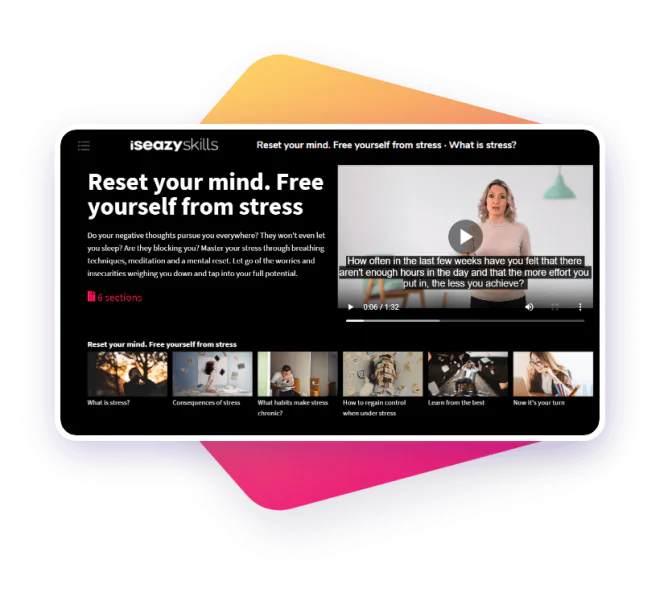Table of contents
ToggleHuman talent is an indispensable asset in any organization, large or small. So, it’s natural that, in the current business landscape, talent management is viewed as a strategic priority for success. The ability to recruit, retain and enhance the very best talent has become a determining factor for businesses which seek to survive and thrive.
However, although most companies recognize and adopt this strategy, one question still remains: is it enough simply to manage talent, or should we focus instead on its continuous development?
What is talent development?
Talent development is a strategy encompassing a set of deliberate actions designed to enhance the skills, knowledge and competencies of a company’s employees. Such initiatives aim to promote the professional growth of staff by training workers to assume a range of different roles and functions within a company, allowing them to develop successfully over time.
This is a long-term strategy, which begins when an employee is first hired and unfolds throughout their entire career. It goes beyond traditional training, bringing in to play an array of elements such as personal development, leadership, innovation and adaptation to change.
A study by the Work Institute showed that 22% of workers leave their jobs due to a lack of professional development opportunities. This statistic highlights the value of actively prioritizing and encouraging talent development – not only as a strategy to improve talent retention, but also as an investment in the long-term success of a company.
Talent management vs. Talent development: Similarities and differences
The twin concepts of talent management and talent development are often confused. Whilst talent management focuses on recruiting, retaining and managing employees, talent development focuses instead on enhancing their long-term professional growth.
Both strategies are complementary, and both are fundamental for organizational success. However, talent management is slightly more limited, involving processes such as recruitment, selection, performance appraisal and employee retention. Talent development, on the other hand, deals with broader long-term processes such as investing in employees’ personal and professional development, and providing them with the tools, skills and opportunities they need to reach their full potential. These contribute significantly to business growth over time.
Why is talent development so important for companies? The tangible benefits
As the labor market becomes increasingly competitive, organizations are faced with the need to adapt and evolve on a consistent basis. Talent development is not only a natural response to this need, but also a key differentiating factor for those companies who choose to nurture it. This is because businesses that prioritize talent development not only attract higher quality professionals, but also prepare them to assume leadership roles in the future.
Talent development benefits individual employees, but also produces significant advantages for the wider company. Some of the benefits of adopting this strategy include:
Improved individual and collective performance
By enhancing employees’ skills, their individual performance is optimized which, in turn, boosts the collective performance of the organization.
Heightened talent retention
Companies that invest in talent development tend to retain their employees for longer, thereby reducing costs associated with high staff turnover and enhancing their image and competitive edge in the field.
Greater motivation, satisfaction and work environment
Investing in talent brings about tangible changes in employee confidence. It demonstrates that the company cares about its employees, making them feel more satisfied and motivated. At the same time, greater satisfaction leads to a reduction in conflict, which naturally improves the work environment.
A positive impact on productivity and financial results
A well-trained and motivated set of employees contribute directly to improving productivity. This helps companies to achieve their expected results in the shortest possible time, positively influencing the company’s financial outcomes.
Innovative methods to optimize talent development
Talent development has a direct connection to the training and learning opportunities we provide to our employees. However, traditional teaching methods are not the only way of enhancing it. In the digital age, organizations have an array of innovative strategies at their disposal to drive talent development. Some of the most noteworthy methods include:
Emerging technologies in training and development
E-learning platforms, virtual reality, artificial intelligence and data analytics are all revolutionizing the way training is delivered, and professional development encouraged.
Nowadays, employees can access a whole host of different platforms and resources, using online courses to pick up both the soft and hard skills they need to cope with the future of work. These types of tools allow them to learn at their own pace and even in their free time, conveniently adapting to the fast-paced lifestyle of the modern worker.
Gamification: Driving participation
Gamification has become an effective tool for enhancing employee participation and engagement in talent development programs. Gamification tools have reinvented and reinvigorated the way in which talent can be trained, offering them authentic learning experiences designed to prompt real changes in their behavior.
Some of the benefits of gamification include increased employee motivation, engagement, and retention. This strategy also helps to improve performance and productivity, as well as encourage teamwork and collaboration.
Social learning platforms
These platforms are based on social learning theory, which explores how people acquire new knowledge and skills through social interaction and observation. They are designed so that employees can easily share knowledge, collaborate effectively on projects, and participate in communities that encourage the exchange of ideas and collective development. If you want to learn more about modern solutions to boost social learning in your team, then take a look at this article.
Microlearning: Your secret weapon for developing soft skills
Offering employees quick and easy-to-access online learning resources, such as videos, podcasts or courses broken down into smaller training modules, allows them to acquire new skills in a flexible and attractive way. This is microlearning, and some of its greatest benefits include enhanced learning efficiency, speed, and adaptation to real-life work. It can also be applied immediately and has a measurable impact. If you’re eager to learn more about this methodology, then we invite you to read this article.
The 6 key phases of strategic planning for human talent development
To ensure long-term talent development success, it’s essential to carry out proper strategic planning. This planning is a fundamental process that will help your organization to identify development needs, and thus design effective programs that significantly enhance employee growth. The following six key phases collectively form a solid framework for the successful planning and execution of talent development:
1. Strategic planning: Foundations and goals
In the first phase, an organization must clearly define its talent development objectives. These need to be aligned with the company’s wider vision, mission and business strategy. Specific, measurable goals should also be established at this stage, reflecting the needs and priorities of the organization in terms of both talent and key skills.
2. A deep analysis of human teams: Identify your needs
In the second phase, you’ll need to carry out an exhaustive analysis of the skills, knowledge and competencies currently possessed by your team. This analysis will help you to identify potential skills and development gaps. You can also conduct performance reviews, job satisfaction surveys, and one-on-one interviews to understand the specific needs of each individual employee.
3. Continuous training: Design personalized programs
Based on the results of your needs analysis, and guided by the objectives you initially set out, it’s now time to design personalized training programs that address priority development areas for each employee and team. These programs could include both in-person and online training, mentoring, and hands-on projects to ensure effective and relevant learning.
4. Performance evaluation: Effective tools and methods
With a training program in place that matches your business needs and objectives, it’s crucial to implement effective tools and methods to evaluate employee performance and progress. In this phase, you can include regular assessments, objective reviews, 360º feedback, and implement precise measurements of key performance indicators.
5. Integrate strategic recruitment into your talent development plan
To ensure a consistent flow of high-quality talent, it’s important to integrate talent development initiatives into your organization’s recruitment and selection strategies. This could involve identifying candidates with high growth potential, implementing effective onboarding processes, and creating strong development opportunities for new employees.
6. Recognition and retention: Strategies to ensure continuity of talent
In this final phase, you should implement effective recognition and retention strategies to ensure good talent continuity. This will allow you to maintain high levels of commitment and motivation among employees. Strategies can include implementing recognition and reward programs, offering growth opportunities, and fostering collaborative work.
If you’re unsure about how to take the first step forward in developing your team’s talent, don’t worry. With isEazy Skills, you’ll have the market’s most complete catalog of courses at your disposal, all designed to help you enhance your team’s skills. Get your employees to cover any need, profile, position or sector through a host of agile, interactive and accessible soft skills courses. Request a demo today and start developing your professionals’ talent, through quality experiences and resources that will help them hold on to everything they learn. Are you ready?














